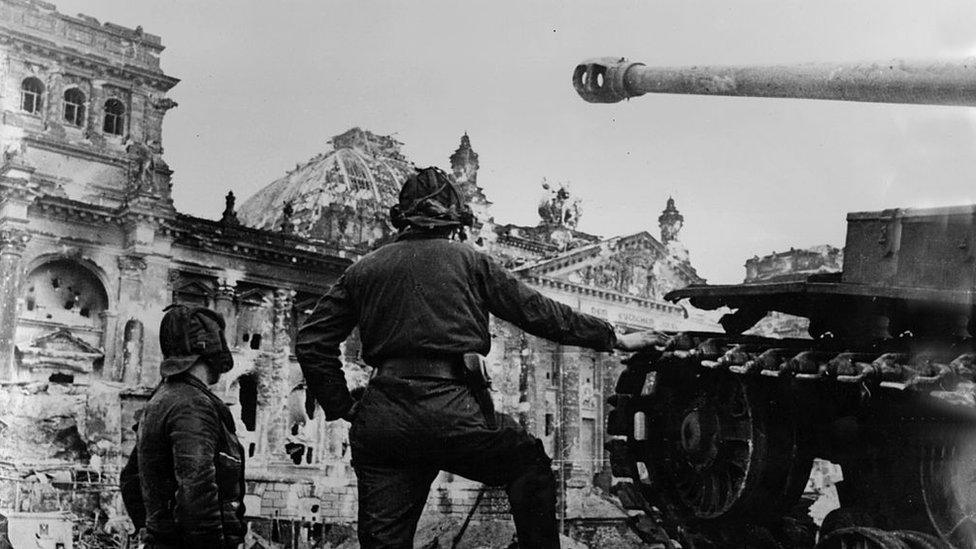VE Day: The fall of Nazi Berlin in pictures
- Published

Berlin finally fell after more than two weeks of brutal street-by-street fighting
After nearly four years of intense fighting, Soviet forces finally launched their assault on Berlin on 16 April 1945.
Nazi Germany had invaded the Soviet Union in June 1941 and killed an estimated 25 million of the country's civilians and military.
But now, Adolf Hitler's Germany was on its knees. A depleted and disorganised garrison of about 95,000 faced two full Soviet army groups attacking from the east and south.
In total, some 1.5 million Soviet troops encircled and then assaulted the capital. It was the last major offensive of the war in Europe.
Soviet forces encircled the city and attacked on the ground and from the air
Terrified civilians tried to flee the city as Soviet forces advanced
Adolf Hitler refused to leave the capital, spending the last days of his life underground in the so-called F眉hrerbunker in the centre of the city.
He last appeared above ground on his 56th birthday - 20 April 1945 - to award medals to those defending the city.
That same day, Soviet forces began to shell the city centre. Berlin was completely surrounded by 23 April.
The Nazis used old men and children to defend their capital - here Adolf Hitler awards medals to boy soldiers
In total about 1.5 million Soviet troops encircled and assaulted the capital of Nazi Germany
Nazi forces were vastly outnumbered and outgunned, and could do nothing but slow the Soviet advance.
On 30 April 1945, Hitler killed himself, the day after marrying Eva Braun. Their bodies were taken above ground and burned in a bomb crater nearby.
Not long afterwards, Soviet forces captured the shell-damaged Reichstag. A famous staged photo shows a Soviet soldier lifting the flag of the USSR above the historic parliament building.
The famous image of a Soviet flag hoisted over the Reichstag
The city officially surrendered on 2 May, though fighting continued until the end of the war in Europe on 8 May.
Berlin itself was left in ruins. Occupying Soviet troops gave out bread and essentials, but some soldiers also committed atrocities against civilians. Thousands of women were raped.
8 May 1945: Marshal Wilhelm Keitel signs Nazi Germany's unconditional surrender near Berlin
The city was devastated by street fighting and earlier British and US bombing
Soviet forces gave out soup and bread to civilians who remained after the fall of the city
Berlin was occupied by the victorious Allied powers after the war.
Civilians began to clear up the city, and the leaders of the US, UK and USSR all met in the Berlin suburb of Potsdam just months after the war ended to shape the peace.
Civilians quickly began the long task of clearing up the city
The ruins of Potsdamer Platz
British Prime Minister Winston Churchill visited Berlin in July 1945, and sat on a chair outside Hitler's bunker
All pictures copyright.
- Published26 January 2020
- Published1 May 2015
- Published20 June 2011
- Published4 February 2020